High Altitude Pseudo Satellites Market Size and Share
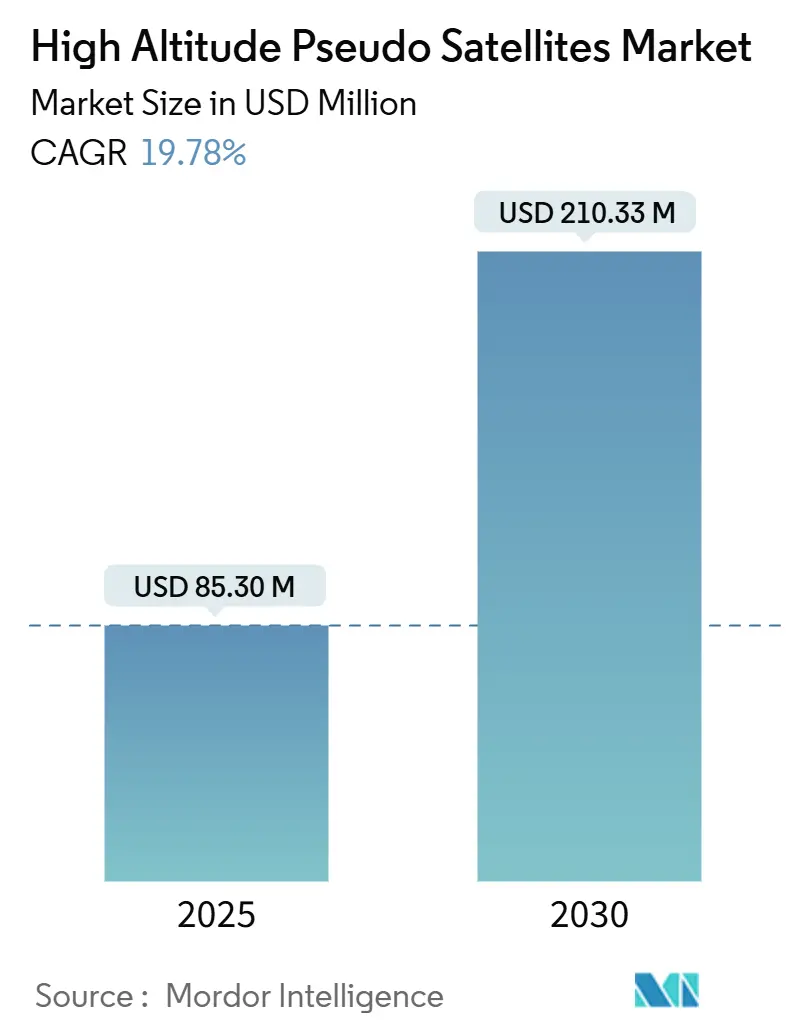
High Altitude Pseudo Satellites Market Analysis by Mordor Intelligence
The high-altitude pseudo-satellite (HAPS) market size reached USD 85.30 million in 2025 and is forecasted to expand to USD 210.33 million by 2030, advancing at a 19.78% CAGR. Rapid progress in 5G/6G non-terrestrial networks, escalating intelligence-surveillance budgets, and sustained advances in ultra-light solar and battery systems are reshaping platform economics, positioning the HAPS market as a cost-effective bridge between terrestrial towers and low-Earth-orbit constellations. Operators are capitalizing on 69% lower transmission costs versus LEO satellites, significantly reduced latency, and the ability to station-keep above 18 to 25 kilometers for months. Platform makers prioritize vertical integration—owning the aircraft, payload, and data services—to shorten time-to-market and meet sovereign digital-infrastructure mandates. Meanwhile, Europe, North America, and Asia-Pacific regulators have opened higher-altitude corridors, creating a clear procedural pathway for commercial flights at FL550 and above.
Key Report Takeaways
- By technology, unmanned aerial vehicles led with a 65.10% share of the HAPS market in 2024; airships are on track to register the fastest 26.40% CAGR to 2030.
- By application, communication platforms commanded 40.65% of the HAPS market size in 2024 and are forecasted to expand at a 22.35% CAGR to 2030.
- By end-user, government and defense entities held 44.25% revenue share in 2024, while commercial enterprises are projected to grow the quickest at a 23.74% CAGR through 2030.
- By power source, solar-electric systems accounted for a 65.20% share of the HAPS market in 2024; hydrogen fuel-cell hybrids are set to record the highest 27.84% CAGR between 2025 and 2030.
- North America captured 33.97% of the HAPS market share in 2024, while Asia-Pacific is forecasted to clock the steepest 24.96% CAGR to 2030.
Global High Altitude Pseudo Satellites Market Trends and Insights
Drivers Impact Analysis
| Driver | (~)% Impact on CAGR Forecast | Geographic Relevance | Impact Timeline |
|---|---|---|---|
| Rapid 5G/6G NTN roll-outs | +4.2% | Global; led by Asia-Pacific and North America | Medium term (2-4 years) |
| Growing ISR and persistent surveillance outlays | +3.8% | North America, Europe, Asia-Pacific defense sectors | Short term (≤ 2 years) |
| Cost advantage over LEO constellations | +3.1% | Global; particularly emerging markets | Long term (≥ 4 years) |
| Advances in ultra-light solar/battery systems | +2.9% | Global technology hubs | Medium term (2-4 years) |
| Carbon-reduction mandates favoring low-emission rural backhaul | +2.4% | Europe, North America regulatory zones | Long term (≥ 4 years) |
| Stratospheric air-traffic corridors opened by regulators | +1.8% | Europe (EASA), North America (FAA) | Short term (≤ 2 years) |
| Source: Mordor Intelligence | |||
Rapid 5G/6G NTN roll-outs
Standardization of high-altitude platforms under 3GPP Release 17 unlocked direct-to-device functionality, giving the HAPS market a tangible boost.[1]3GPP, “Non-Terrestrial Networks (NTN),” 3gpp.org NTT DOCOMO’s March 2025 demonstration in Kenya delivered 4.66 Mbps downlink to ordinary smartphones at 20 kilometers, validating commercial performance. Saudi Arabia’s CST launched a dedicated NTN program, while Japan financed Beyond-5G HAPS research through NICT, showing multi-government alignment. Equipment vendors are now bundling terrestrial core software with HAPS radios, shortening deployment cycles. These moves accelerate spectrum auctions and create first-mover advantages for operators that can field stratospheric coverage before LEO competitors saturate the rural broadband market.
Growing ISR and persistent surveillance outlays
The US National Defense Authorization Act (NDAA) 2024 earmarked fresh funds for ultra-long-endurance HAPS, confirming defense agencies’ willingness to shift part of their satellite spend toward stratospheric assets. India’s 2024-25 budget followed suit, listing high-altitude platforms among priority procurements for the Ministry of Defence. BAE Systems flight-tested its PHASA-35 in 2024, carrying a 15 kg ISR payload for multi-week sorties.[2]BAE Systems, “BAE conducts first successful stratospheric test flight of PHASA-35 HAPS platform,” datacenterdynamics.com Continuous coverage at a fraction of satellite cost has prompted joint European border-security pilots under Frontex, while Asian militaries are scoping maritime-domain-awareness packages. As defense users validate the platforms, dual-use suppliers gain scale economies that strengthen commercial propositions.
Cost advantage over LEO constellations
A techno-economic comparison published in November 2024 showed that one regional HAPS requires a USD 4.4 million life-cycle spend versus a USD 1.5 million LEO satellite, yet delivers wider contiguous coverage and eliminates constellation replenishment.[3]IEEE Communications Magazine, “Techno-Economic Considerations of LEO, HAPS, and UAV Technologies for 6G Connectivity,” static.crysys.hu Transmission costs are 69% lower than those of LEO links because elevation angles improve ground-terminal efficiency. Rural mobile operators use these economics to justify HAPS instead of tower builds, which cost USD 200,000 per remote site. GSMA modelling revealed that a five-platform cluster can bridge a 12,000-square-kilometer dead zone at one-third the cost of terrestrial infrastructure. These cost insights prompt financiers to treat HAPS as an infrastructure-as-a-service asset class comparable to cell towers and small-sat constellations.
Advances in ultra-light solar/battery systems
Airbus’s Zephyr completed a record-setting 67-day flight in May 2025, powered by Amprius silicon-anode batteries with 450 Wh/kg specific energy. Weight reductions of 25% over 2024 designs enabled a 20% payload bump without lengthening the 27.8-meter wing, proving the scalability of thin-film photovoltaics. NASA-funded trials on Swift Engineering’s SULE in January 2025 hit 55,904 feet, validating panel durability at -50°C. AM material advances allow modular battery packs to slide out at recovery for rapid turnaround. These breakthroughs are lengthening mission profiles from weeks to multiple months, a prerequisite for commercial data-service SLAs.
Restraints Impact Analysis
| Restraint | (~)% Impact on CAGR Forecast | Geographic Relevance | Impact Timeline |
|---|---|---|---|
| High CAPEX and maintenance cost per flight-hour | -2.7% | Global; cost-sensitive markets | Medium term (2-4 years) |
| Spectrum and airspace regulatory complexity | -1.9% | Global; varying by jurisdiction | Short term (≤ 2 years) |
| Stratospheric wind-shear unpredictability | -1.4% | Global operational zones | Long term (≥ 4 years) |
| Insurance and liability gaps for more than 30-day unmanned sorties | -1.2% | Global commercial operations | Medium term (2-4 years) |
| Source: Mordor Intelligence | |||
High CAPEX and maintenance cost per flight-hour
Platform builds priced at USD 4 to 7 million and specialized hangar requirements raise the entry bar for smaller players. Extended sorties necessitate reinforced structures that withstand radiation and -90 °C stratospheric temperatures, driving material costs. Maintenance activities—especially post-flight inspection of composite skins—are labor-intensive and can exceed USD 4,000 per aircraft-day. Insurance products remain limited; hull premiums are still priced at a high perceived risk due to the small global fleet size. Until volume production lowers unit cost, CAPEX will constrain deployments in low-ARPU regions.
Spectrum and airspace regulatory complexity
Operators must harmonize ITU IMT frequencies with national aviation approvals, creating a multi-agency approval loop that can stretch for 18 months. Cross-border flights trigger bilateral overflight permissions, and spectrum managers in adjoining countries often allocate different duplex gaps, complicating radio planning. While EASA and FAA have issued draft guidelines for FL550+, each state still controls flight rules below its sovereign ceiling, producing a patchwork of licensing processes. These complexities inflate compliance budgets and delay commercial service launches.
Segment Analysis
By Technology: Airships gain speed as payload front-runners
Unmanned aerial vehicles (UAVs) led with 65.10% of the HAPS market share in 2024, a position built on precise station-keeping, rapid launch cycles, and mature autonomous-flight software. Stratospheric balloons retained a solid niche to lower development costs, while airships remained the fastest-growing sub-segment with a 26.40% CAGR projected to 2030 as operators target heavier multi-sensor payloads. From 2019 to 2024, UAVs consolidated leadership by proving consistent link budgets for broadband backhaul, persistent ISR, and high-resolution imaging—all within a single hardware baseline that can be re-tasked in hours instead of weeks. The HAPS market benefits because platform owners can shift craft from disaster response to telecom backhaul without structural modification, tightening utilisation rates, and improving return on capital.
Hybrid designs that combine balloon lift with airship thrusters are emerging, capturing early fleet orders from disaster-response agencies needing rapid launch and dynamic repositioning. Sceye’s 24-meter-long demonstrator logged a 45-day methane-mapping mission for NASA in late 2024, carrying a 150 kg hyperspectral suite. The HAPS industry also experimented with rigid-wing UAVs; Swift Engineering’s SULE offers near-satellite pointing accuracy for telecom payloads but at lower lift. Competition among architectures spurs material-science innovation, ultimately lowering the cost-per-bit for air-launched payloads.
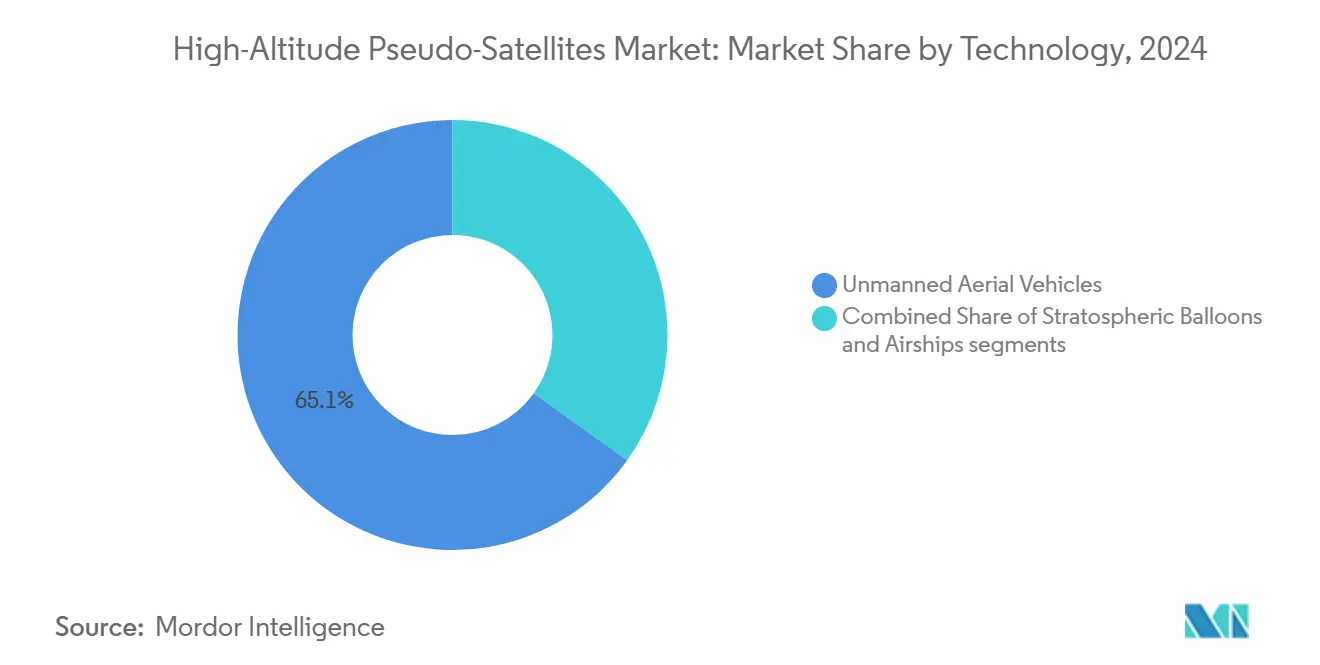
Note: Segment shares of all individual segments available upon report purchase
By Application: Connectivity continues to lead, while earth observation accelerates
Communication services held 40.65% of the HAPS market size in 2024, underpinned by direct-to-device pilots in Japan, the United States, and Kenya. Earth-observation demand is rising faster as multiband imagers deliver 5-centimeter GSD across 1,000-kilometer sweeps, lowering revisit intervals versus 500-kilometer LEO passes. ISR remained pivotal for defense customers, but the highest 22.35% CAGR belongs to commercial connectivity, where platforms are being slotted into mobile-edge architectures to offload rural traffic.
From 2019-2024, the mix was heavily skewed toward military trials; in 2025-2030, enterprise use cases such as agricultural analytics, wildfire detection, and rail-corridor monitoring will account for a larger share of service revenue. The HAPS market benefits because payload makers are packaging sensors with onboard AI accelerators, compressing analysis windows from hours to seconds. Navigation and positioning pilots in Japan revealed that adding a pseudolite beacon can enhance GNSS accuracy by 45% in deep-urban canyons.
By End-User: Commercial operators set the growth pace
Government and defense agencies preserved a 44.25% revenue stake in 2024. Still, commercial firms are heading for the steepest 23.74% CAGR through 2030, reshaping ownership models across the HAPS market. Telecom carriers are taking minority stakes in platform builders—SoftBank partnered with AeroVironment on the Horus A to secure early access to 150-pound payload capacity for 5G backhaul. Research institutes like CSIR-NAL continued flight tests that aim to de-risk civilian air-traffic integration for dual-use missions.
Between 2019 and 2024, national mandates dominated procurement. In the 2025-2030 window, private spectrum licensees look set to anchor service revenues, bundling HAPS capacity with satellite and terrestrial options inside a unified core network. The HAPS industry is therefore pivoting from platform sales to capacity-leasing models, mirroring the tower-sharing playbook that unlocked mobile coverage in the early 2000s.
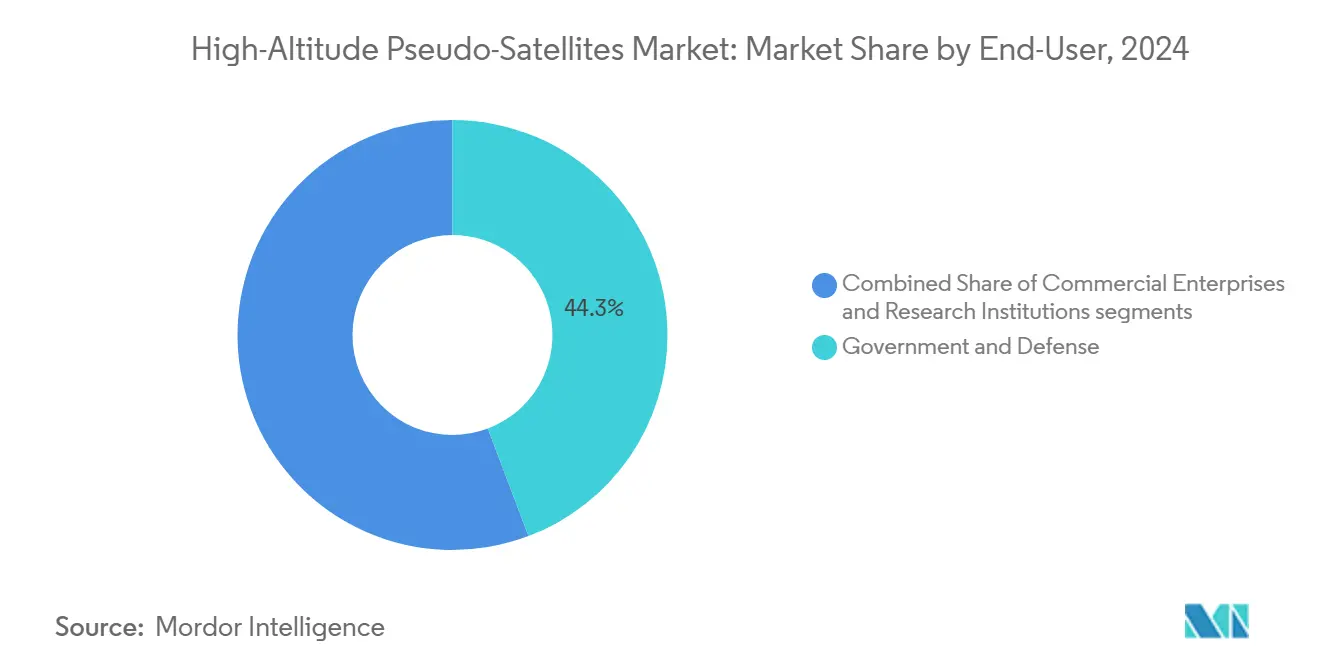
Note: Segment shares of all individual segments available upon report purchase
By Power Source: Hydrogen hybrids rewrite endurance rules
Solar-electric propulsion retained a 65.20% share in 2024 thanks to the maturity of thin-film PV and proven Zephyr flights. However, hydrogen fuel-cell integration is accelerating at a 27.84% CAGR, giving the HAPS market a credible path to year-round station-keeping at high latitudes where winter insolation drops sharply. Battery-only craft remain relevant for quick-launch missions of 7-10 days, where payload swap-out speed outweighs duration.
Hybrid stacks produce 2-3 kW continuously, enough to power multi-band 3GPP radios, lidar, and machine-learning accelerators. Deutsche Telekom’s 2024 ground demo showed that a 60-gram hydrogen PEM stack could double night-time power reserves without penalizing daytime climb rate. As liquid-hydrogen micro-tanks become aerodynamically conformal, the HAPS market will shift toward multi-fuel architectures that optimize cost-per-flight-hour across latitude bands, seasons, and payload classes.
Geography Analysis
North America accounted for 33.97% of 2024 revenue, aided by FAA traffic-management frameworks and strong R&D spending by NASA and the US Space Force. AeroVironment posted USD 717 million in fiscal 2024 sales, up 33%, reflecting defense demand for unmanned systems that include high-altitude prototypes. States such as Arizona and New Mexico have also allocated tax incentives for HAPS assembly facilities, reinforcing regional supply-chain depth.
Asia-Pacific is projected to expand at 24.96% CAGR through 2030, the fastest among all regions, elevating the HAPS market profile across Japan, India, and Australia. Japan’s USD 100 million AALTO consortium deal in 2024 paved the way for 2026 commercial launches, while SoftBank earmarked 2027 for mass-market roll-out. India’s CSIR-NAL completed pseudo-satellite airtime tests that align with its spectrum road map for 6G field trials. South Korea and Australia are co-funding tech demonstrators at Arctic and maritime coverage gaps elsewhere.
Europe holds a sizeable installed base and is advancing standard-setting. EASA’s Higher Airspace Operations blueprint set 2027 as the target for unified certification, while ESA’s TELEO project is funding both aerostatic and aerodynamic demonstrators. The region’s climate-policy tilt favors zero-emission backhaul, further supporting adoption. Member states like France and Spain are piloting HAPS for wildfire monitoring, showing that environmental applications can dovetail with telecom use cases to build volume.
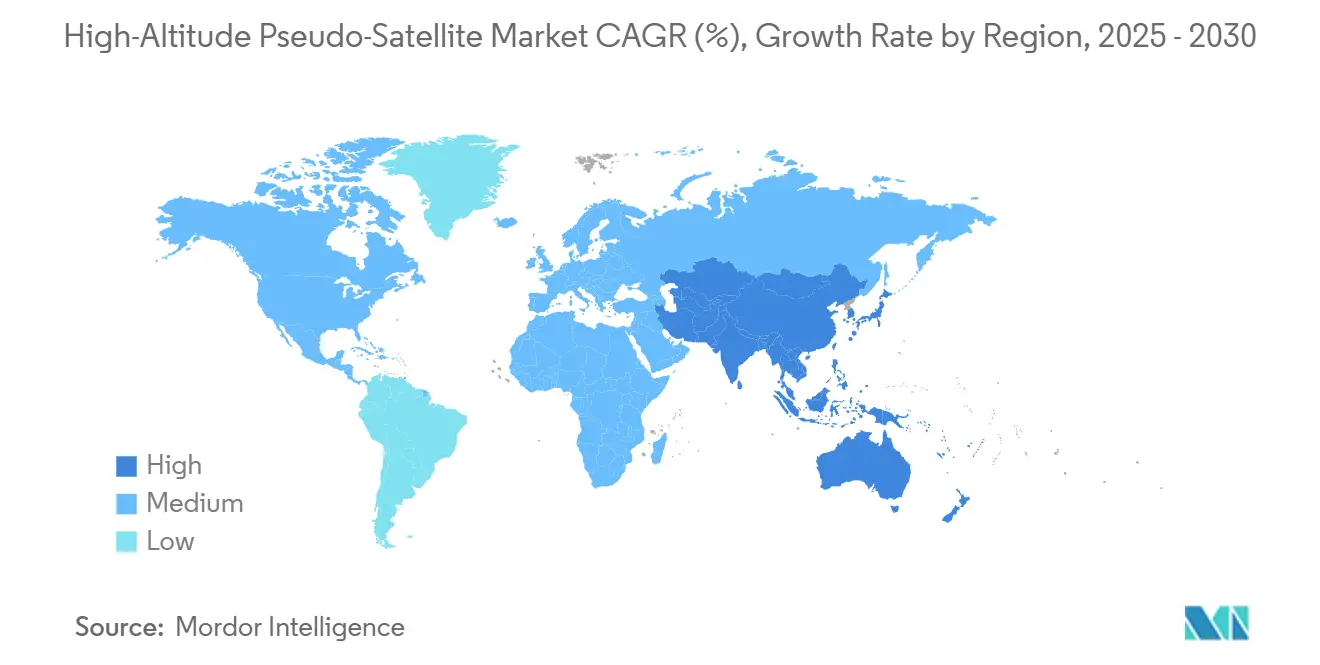
Competitive Landscape
The high-altitude pseudo-satellites (HAPS) market displays moderate concentration, with aircraft integrators, telecom operators, and payload makers forming cross-industry alliances. Airbus leads on endurance metrics via Zephyr and controls AALTO, the first vertically integrated commercial provider to raise a nine-figure investment for Asian roll-out. AeroVironment leverages its unmanned-air-system pedigree to advance Horus A with SoftBank, targeting 1.5 kW payload power for 5G backhaul. BAE Systems and Sceye focus on ISR and climate-monitoring niches, respectively, and they are gaining traction through government grants and agency contracts.
Strategic themes include vertical integration to control the full data stack and capacity leasing to telecom carriers that lack aerospace know-how. Several incumbents have moved to secure material supply chains; Amprius signed a long-term cathode contract with Airbus in 2025, locking in high-energy batteries for next-gen Zephyr flights. White-space entrants chase edge-computing payloads: World View packages sensor data with an AWS-compatible analytics stack. At the same time, Sceye integrates methane algorithms at the platform level to shorten delivery cycles to oil-and-gas clients.
Disruptors are also attacking propulsion. Mira Aerospace is prepping a 60-kilo-payload solar craft for Middle-East launches in 2025, pitching modular payload bays that slide into the keel cavity for two-hour swaps. Meanwhile, HAPS Alliance members are developing common avionics interfaces to avoid the fragmentation that slowed early small-sat projects. Competitive intensity will remain high as platform counts rise; IP barriers around aerodynamics, energy storage, and stratospheric weather modelling prevent a rapid commoditization of hardware.
High Altitude Pseudo Satellites Industry Leaders
-
AeroVironment, Inc.
-
Thales Group
-
BAE Systems plc
-
Airbus SE
-
Aurora Flight Sciences (The Boeing Company)
- *Disclaimer: Major Players sorted in no particular order
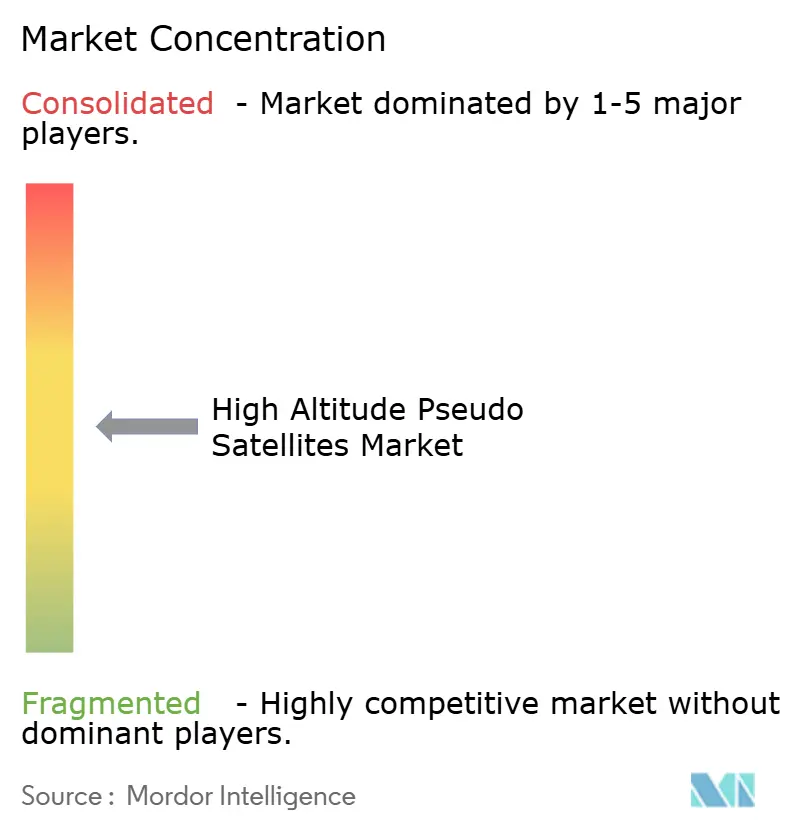
Recent Industry Developments
- May 2025: AALTO Zephyr completed a 67-day stratospheric flight using Amprius ultra-high-energy batteries, setting a new solar-powered endurance record.
- March 2025: Airbus US Space & Defense broadened its collaboration with Aerostar and Persistent Systems to strengthen HAPS offerings for defense and commercial clients.
- October 2024: Sceye partnered with NASA and USGS on climate-monitoring flights and secured USD 525 million in Series C funding.
Research Methodology Framework and Report Scope
Market Definitions and Key Coverage
Our study defines the high-altitude pseudo-satellites market as solar- or hybrid-powered unmanned airships, balloons, and fixed-wing platforms that operate in the stratosphere between 18 km and 30 km, deliver persistent communication, intelligence, surveillance, reconnaissance, and earth-observation services, and are sold as new complete systems to defense, governmental, and commercial operators. According to Mordor Intelligence, the global market is valued at about USD 85.30 million in 2025 and is tracked through 2030.
Scope exclusion: After-sales spares, payload upgrades, and launch support services are not counted.
Segmentation Overview
- By Technology
- Stratospheric Balloons
- Unmanned Aerial Vehicles
- Airships
- By Application
- Communication and Connectivity
- Intelligence, Surveillance and Reconnaissance (ISR)
- Earth Observation and Climate Monitoring
- Navigation and Positioning
- Scientific and Research Missions
- By End-User
- Government and Defense
- Commercial Enterprises
- Research Institutions
- By Power Source
- Solar-Electric
- Hybrid Hydrogen-Fuel-Cell
- Battery
- By Geography
- North America
- United States
- Canada
- Mexico
- Europe
- United Kingdom
- France
- Germany
- Italy
- Rest of Europe
- Asia-Pacific
- China
- India
- Japan
- Australia
- South Korea
- Rest of Asia-Pacific
- South America
- Brazil
- Rest of South America
- Middle East and Africa
- Middle East
- Saudi Arabia
- United Arab Emirates
- Turkey
- Rest of Middle East
- Africa
- South Africa
- Rest of Africa
- Middle East
- North America
Detailed Research Methodology and Data Validation
Primary Research
Mordor analysts interviewed propulsion engineers, stratospheric test-range managers, spectrum regulators, and procurement officials across North America, Europe, and Asia. These discussions helped us validate endurance assumptions, typical platform pricing, and regional deployment hurdles, closing information gaps found during desk work.
Desk Research
We began with public datasets that report on stratospheric airspace usage and broadband-coverage gaps, such as NASA flight logs, the US Federal Aviation Administration unmanned aircraft registry, International Telecommunication Union connectivity statistics, and European Space Agency stratospheric flight test archives. Our team also pulled defense budget line items for persistent ISR programs, customs shipment codes for composite airframes, and patent filings on high-efficiency solar films via Questel to benchmark technology readiness.
Next, we tapped D&B Hoovers for company financials, Dow Jones Factiva for program announcements, World Bank rural-population trends, and respected trade associations like the Global Uncrewed Traffic Management Alliance to round out production and demand signals. These sources illustrate our approach and are not exhaustive; many additional references supported data checks and clarification.
Market-Sizing & Forecasting
We apply a top-down build that starts with known prototype counts, planned procurement budgets, and regional telecom-backhaul white spots, which are then translated into unit demand through platform endurance and service-life metrics. We corroborate the totals with selective bottom-up checks that roll up sampled average selling prices from supplier disclosures and channel insights. Key variables in our model include stratospheric flight hours logged, solar-cell efficiency gains, defense ISR allocation growth, 5G coverage deficit by population, and energy-storage density improvements. Multivariate regression forecasts each driver, and scenario analysis stress tests high-growth and restrained adoption cases before we lock the base case.
Data Validation & Update Cycle
Outputs are triangulated against historical HAPS crash statistics, manufacturer backlogs, and satellite-capacity lease prices. Any variance beyond preset thresholds triggers a senior review and a call back to high-priority respondents. Reports refresh once a year, and we issue interim revisions when material program awards or regulatory shifts occur. A last-mile analyst check is conducted before delivery.
Why Mordor's Pseudo-Satellite Baseline Commands Reliability
Published estimates seldom match because publishers pick different scopes, base years, and currency conversion points, and they refresh models at varied cadences. We recognize these factors upfront, and our disciplined inclusion criteria, driver selection, and annual update rhythm keep our baseline steady yet current.
Key gap drivers include broader "high-altitude platform" scopes used by some firms, older or more aggressive base-year exchange rates, and models that assume immediate mass production ramps without validating endurance test data.
Benchmark comparison
| Market Size | Anonymized source | Primary gap driver |
|---|---|---|
| USD 85.30 m (2025) | Mordor Intelligence | - |
| USD 104.5 m (2024) | Regional Consultancy A | Includes tethered aerostats and service contracts |
| USD 99 m (2024) | Global Consultancy B | Uses single average platform price, omits regional weighting |
| USD 85 m (2023) | Trade Journal C | Older base year, does not adjust for inflation |
Taken together, the comparison shows that our carefully bounded scope, driver-led model, and timely updates produce a balanced, transparent foundation that decision-makers can rely on with confidence.
Key Questions Answered in the Report
What is driving the current growth of the high-altitude pseudo-satellites market?
The main catalysts are 5G/6G non-terrestrial network roll-outs, rising ISR budgets, and breakthroughs in solar-battery endurance that lower cost-per-bit.
How large will the high-altitude pseudo-satellites market be by 2030?
It is projected to reach USD 210.33 million by 2030, expanding at a 19.78% CAGR from its 2025 base.
Which technology segment is growing the fastest?
Stratospheric airships are forecast to grow at 26.40% CAGR, overtaking balloons as payload and station-keeping requirements rise.
Why are hydrogen fuel-cell hybrids important?
They provide continuous power when solar irradiance is low, enabling year-round operations and projected 27.84% CAGR in the power-source segment.
Which region offers the greatest expansion opportunity?
Asia-Pacific is set to post a 24.96% CAGR through 2030, supported by sizeable Japanese and Indian investments.
How concentrated is the competitive landscape?
The top five firms control roughly 47% of revenue, indicating moderate concentration but plenty of room for niche entrants.
Page last updated on:



